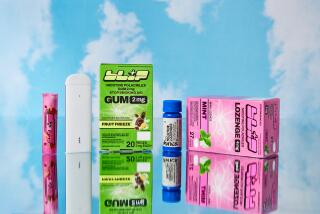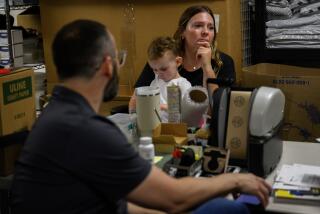An ‘epidemic of nicotine addiction’ among kids prompts FDA to get tough on e-cigarette makers
Responding to an “epidemic of nicotine addiction” among American youths, the U.S. Food and Drug Administration on Wednesday announced a comprehensive crackdown on e-cigarette manufacturers, directing the industry’s giants to draw up detailed plans for halting sales to minors and threatening to pull a wide range of products, including flavorings that appeal to underage buyers.
FDA Commissioner Scott Gottlieb called the agency’s steps the largest coordinated enforcement effort in his agency’s history and said it was prompted by alarming new evidence that electronic cigarette use by minors has risen to levels he called “simply not tolerable.”
In response to a nationwide undercover investigation of brick-and-mortar and online stores over the summer, the FDA levied civil fines ranging from $279 to $11,182 on e-cigarette retailers found to have sold their products to minors and issued more than 1,300 warning letters.
What’s more, Gottlieb said the vaping industry appears to have turned a blind eye to the online practice of “straw purchasing” by retailers and individuals intent on buying vaping products and reselling them to minors.
The agency also ordered 12 online retailers to halt their continued marketing of e-liquids resembling kid-friendly products like candy and cookies. Although the FDA had acted in May to limit the sale of such products, they were still being offered, with the offending labeling and advertising, by the 12 online retailers, several of whom were also cited for sales to minors.
The new enforcement actions mark the start of a “sustained campaign to monitor, penalize and prevent e-cigarette sales in convenience stores and other retail sites” to minors, Gottlieb said. He promised, too, that the FDA would be keeping close tabs on manufacturers’ own internet storefronts and distribution practices to detect sales to minors.
“The FDA has at its disposal both civil and criminal remedies to address demonstrated violations of the law,” he said.
The actions were greeted with defiance and derision from the vaping industry.
“Thousands of small-business vape shops across America do not engage in irresponsible marketing practices and don’t even sell the products being targeted by the FDA with threatening letters,” said Gregory Conley, president of the American Vaping Assn., a nonprofit organization that advocates for what it calls sensible regulation.
“Despite this, Commissioner Gottlieb is threatening to shut down all these businesses unless larger manufacturers unilaterally choose to change their marketing practices,” Conley added. “It is absolutely absurd and a perversion of how regulatory agencies are supposed to approach their work.”
Conley called Gottlieb’s initiative “nothing more than a gift to the tobacco industry,” whose stock prices jumped on news of the FDA’s vaping crackdown.
Public health groups, on the other hand, said lax regulation was the reason teen vaping became such a problem in the first place.
The American Cancer Society Cancer Action Network called Wednesday’s actions a “necessary first step” but said officials could do much more.
“FDA for years has repeatedly missed opportunities to keep tobacco products out of the hands of our children,” said Chris Hansen, the organization’s president. “Clearly the FDA knows who the industry culprits are in this epidemic and as such should exercise its full regulatory authority over these products rather than allow the industry to voluntarily self-correct.”
The American Academy of Pediatrics also scolded the FDA for giving e-cigarette manufacturers more time to flout rules against selling their products to kids. The academy said Gottlieb has the authority to intervene in the market to protect minors, and any further delay runs the risk that “a generation of young people will become addicted to these dangerous products.”
The FDA has given makers of e-cigarettes until 2022 to seek its approval for products that were on the market by August 2016. On Wednesday, Gottlieb threatened to revisit that deadline and urged manufacturers to voluntarily improve their practices. But he stopped short of requiring any such changes.
E-cigarettes have become the tobacco product most commonly used by American adolescents. Their popularity is rising “very sharply,” Gottlieb said: In 2017, more than 2 million middle and high school students acknowledged they were current users of vaping products, according to the Monitoring the Future survey.
Data from the Centers for Disease Control and Prevention indicate that e-cigarettes have become the tobacco product of choice among middle and high school students.
In 2017, 11.7% of high schoolers who participated in the CDC’s National Youth Tobacco Survey said they had vaped a tobacco product within the last month, up from 1.5% in 2011. In addition, 3.3% of middle school students called themselves current users of e-cigarettes, up from 0.6% in 2011.
The U.S. market for vaping products has exploded as well. Analysts at Wells Fargo estimated that Americans bought more than $2.3 billion worth of e-cigarettes between August 2017 and last month, and they expect annual sales to reach nearly $4 billion this year.
Add in other vaping products — including vapor cartridges and related items sold at specialty shops — and analysts say the entire market could be worth $6.6 billion this year.
In a speech at the agency’s headquarters in Silver Spring, Md., Gottlieb acknowledged that e-cigarettes present a public health conundrum.
In its bid to wean adult smokers from traditional cigarettes, the agency has sought to make a wider range of “reduced risk” tobacco products available to consumers. Those products include e-cigarettes.
At the same time, the FDA has sought to avoid creating a new generation of Americans addicted to those products, or to the nicotine that has served as a powerful hook.
On Wednesday, Gottlieb put manufacturers on notice that the agency’s balancing act will lean more heavily on preventing youth addiction.
“This may create some obstacles for adults who want to enjoy e-cigarettes,” Gottlieb said. “But in closing the on-ramp for kids, we’re going to have to narrow the on-ramp for adults.”
Gottlieb also signaled that his agency is prepared to take more sweeping steps. He gave five e-cigarette manufacturers — the makers of Vuse, Blu, Juul, MarkTen XL, and Logic vaping products — two months to submit plans to “immediately and substantially reverse these trends.”
Failure to comply might prompt the agency to reconsider an earlier decision that gave manufacturers of tobacco products not on the market by August 2016 more time to submit new products to the FDA for pre-market review. He also said the agency is “considering the immediate removal … from the market” of e-cigarette flavorings that cater to underage users.
“Let me be clear: Everything’s on the table,” said Gottlieb.
Juul is the clear leader among e-cigarette brands, with $454 million in sales over the 12 months ending in February, according to the Wells Fargo report, which cited market data from the research firm Nielsen. Other big players are owned by big tobacco conglomerates; Camel parent British American Tobacco makes Vuse e-cigarettes, and Marlboro parent Altria makes MarkTen e-cigarettes.
Collectively, the five industry leaders command more than 97% of the U.S. market for e-cigarettes, and Gottlieb took them to task for their response to concerns expressed earlier by the FDA about underage marketing and sales.
“They treated them as a public relations challenge,” Gottlieb said. “They’re now on notice.”
As part of its effort to turn the tide, the agency launched a new campaign to educate children and teens about the dangers of e-cigarettes. A primary concern for health experts is that kids will become addicted to nicotine and graduate to traditional cigarettes, putting them at risk for lung cancer. A report in the Journal of the American Medical Assn. found that 20% of high schoolers who vaped frequently at the start of the study were smoking cigarettes frequently six months later, and an additional 12% were smoking occasionally. Meanwhile, among students who never vaped, only 2% started smoking during the same period of time.
There are other concerns as well. The aerosol that e-cigarette users inhale contains volatile organic compounds, heavy metals and other chemicals that may cause cancer, according to the CDC. Some flavorings contain diacetyl, a compound that can damage airways if inhaled and may cause lung disease. And a 2016 report from the Office of the Surgeon General warned that nicotine could interfere with healthy brain development during adolescence, especially in regions related to attention, learning and impulse control.
The Campaign for Tobacco-Free Kids said the steps announced by Gottlieb “have the potential to make a fundamental difference.” But, the group added, that will only be the case if the FDA acts quickly to ban e-cigarettes that have not yet been reviewed by the agency, requires all e-cigarettes to submit to immediate FDA review, and forces the manufacturers “that have fueled this epidemic” to change their marketing and sales practices.
Gottlieb said the FDA will continue to monitor underage trends and promised to release new data on e-cigarette use by minors in the coming months. Further evidence of rising rates of use would bring stiffer actions, he vowed.
“Industry must step up to this problem,” he said. “They must demonstrate they’re truly committed to keeping their products out of the hands of kids.”
Staff writer James Rufus Koren contributed to this report.
MORE IN SCIENCE
UPDATES:
3:40 p.m.: This story has been updated with additional information about the fines levied on retailers as well as reaction from the American Academy of Pediatrics and the Campaign for Tobacco-Free Kids.
12:35 p.m.: This story has been updated with additional information about the popularity of e-cigarettes among teens, estimates of e-cigarette sales, the health effects of vaping and reaction from public health groups.
This story was originally published at 10:30 a.m.







